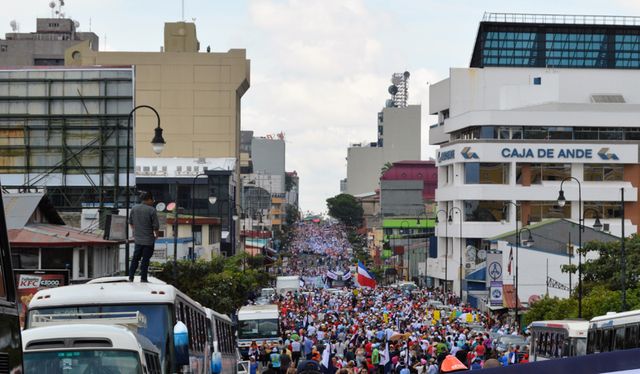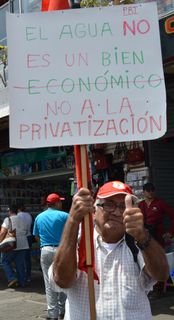James Cogan
The Coalition government headed by Prime Minister Malcolm Turnbull brought down its 2016–2017 financial year budget last night, laying out the campaign slogans and agenda it will take to the federal election due to be called in the next week. Polling day is almost certain to be set for Saturday, July 2.
In his speech to the federal parliament, Treasurer Scott Morrison claimed that the first Turnbull budget was an “economic plan for jobs and growth.” The government’s estimates of revenue, however, are based on fanciful predictions of growth as the global economic downturn deepens.
Morrison declared the country was making a “transition” from an “unprecedented mining investment boom”—largely based on high-priced, large volume resource exports to China—to a “new economy” driven by an “ideas’ boom.” The Treasury department predicted that economic growth in Australia would increase from 2.5 percent over the coming 12 months, to 3 percent during each of the following financial years to 2020–2021.
The absurdity of such figures was demonstrated even before Morrison rose to his feet to deliver the speech. Just hours earlier, in a virtual vote of no confidence in government policies, the Reserve Bank of Australia cut its base interest rate to a historic low of 1.75 percent. This action was taken in response to data revealing that Australia has joined numerous other countries by slumping into deflation, with a fall of 0.2 percent in the consumer price index in the first three months of the year. Further interest cuts are expected, with the RBA warning that global growth estimates had been downgraded again and highlighting the continuing slowdown in China, Australia’s largest export market and trading partner.
Even as Treasury provided Morrison with predictions of sustained growth for the next five years, it was compelled to note falls of more than 25 percent in mining investment in 2015–16 and 2016–17. Since the peak of the mining boom in 2010–2011, the price for major Australian mining exports, such as iron ore and coal, have fallen as much as two-thirds, plunging the balance of trade into large deficits. The budget paper observed: “Low inflation, low wage growth and low productivity growth being experienced in many advanced economies could become embedded in lower growth potential over time.”
The vice president of global credit rating agency Moody’s, Marie Diron, poured cold water on the government’s budget forecasts. She declared: “We estimate that the adjustment to an environment of lower commodity prices is still underway and will continue to weigh on corporate profitability and wage growth. As a result, improvements in the government’s revenues may be somewhat more muted than currently budgeted.”
The reality of Australian capitalism is that further global shocks could send it over the economic precipice, triggering a collapse in the speculative real estate bubble that has been largely responsible for what growth has taken place. The country’s major banks are highly exposed to an increase in corporate bankruptcies and household debt defaults, caused by falling property prices and rising unemployment.
The fiction that Australia will return to growth regardless of the state of the global economy enabled Morrison to announce a return to budget surpluses from massive budget deficits sometime in the early 2020s—without announcing austerity measures on the scale imposed in the US and Europe. The budget is, nevertheless, predicated upon ongoing and draconian cutbacks to the living standards and social rights of the working class, in order to finance three key measures: the ramping up of military spending, spelled out in the January Defence White Paper, the reduction of the corporate tax rate and small tax reductions for the highest income earners.
The military budget rises by 3.1 percent to $32.3 billion. This is the first increment in increases that will see $195 billion spent over the next decade on the acquisition of new warships, aircraft and submarines, as part of the US-led war preparations against China. Australia’s military deployments in Afghanistan, Syria and Iraq have been funded for the next 12 months to the tune of $686 million.
The corporate tax cuts begin for small-to-medium businesses with turnovers of less than $10 million. Their tax rate will fall from July 1 to 27.5 percent, from the current 28.5 percent. Over the following decade, the rate for all companies, large and small, will be reduced to 25 percent. At the same time, the income threshold at which individuals begin paying 37 percent tax on their income will rise from $80,000 to $87,000—an amount earned by less than 25 percent of tax payers. The main beneficiaries will be the top 3–4 percent, who pay 45 cents in the dollar on income earned over $180,000. They will also gain from the elimination of a temporary 2 percent tax increase that was introduced in 2014.
The hand-outs to business and the wealthy will lower revenue by $9.25 billion over four years. The expansion of military expenditure will cost billions more. It will be paid through the ongoing war against the working class, conducted by successive Labor and Coalition governments since the 1980s, leaving millions in financial stress or outright poverty.
Among the most brutal measures are:
* 30,000 unemployed young people aged under 25 will be pushed each year into a “voluntary” cheap labour scheme that enables private businesses to employ them as government-subsidised “interns.”
* Subsidies to aged care providers for complex health services will be cut by $1.2 billion over four years. Incentives for pathology and radiology providers to “bulk-bill,” rather than charge clients up-front for services, will be axed, saving more than $600 million.
* 90,000 disability support pensioners will be subjected to eligibility requirements, forcing at least 30,000 onto the unemployment benefit, which pays $130 less per week. All new aged pension and welfare applicants will receive 1.7 percent less than the current already below-poverty-line payments, by denying them the so-called compensation handed out in 2011 for the former Labor government’s now defunct tax on carbon emissions. The savings will be directed into financing the National Disability Insurance Scheme (NDIS), which was launched by Labor in 2012 with the primary aim of privatising disability services and driving disabled people into the workforce.
* Government departments will have to find “efficiency” savings of $1.9 billion, leading to thousands of public sector job losses, on top of more than 10,000 redundancies since 2013. Entire areas of the public sector are being prepared for privatisation as part of the NDIS and the contracting out of Medicare payment services.
* Tens of billions of dollars in funding, cut in 2014 from grants to state governments to finance public health and education, have not been reinstated. In response, the Australian Medical Association declared that the health system faced a “funding black hole.” The federal government has handed to the states the task of imposing deeper cutbacks to already vastly underfunded and increasingly dysfunctional public health and education services. While plans to de-regulate university fees have been shelved for the time being, funding to universities will be cut by 20 percent over the coming years.
* If re-elected, the Turnbull government will resubmit legislation that was blocked in the Senate in 2014 and 2015 and which, if passed, will inflict over $13 billion in welfare cuts. These will affect the poorest sections of society. The measures include changes to family tax benefit eligibility, reductions in pharmaceutical benefits, a one-month waiting period for young people to access income support, and raising from 24 to 25 the age at which individuals can qualify for the higher Newstart unemployment benefit, rather than the Youth Allowance. The Coalition will also attempt to push through an increase in the aged pension eligibility age from 67 to 70, for all citizens born after 1965.
In an attempt to deflect populist accusations by the opposition Labor Party and the Greens, to the effect that its budget favoured the rich and the major corporations, the Turnbull government introduced changes to various concessions that have enabled the wealthiest individuals to avoid tax by directing income into their superannuation (private retirement) funds. It also announced a crackdown on multi-national tax evasion, modelled on the “Google tax” introduced by the Cameron government in the UK.
As the details and implications of the budget measures filter out, however, a groundswell of condemnation is already developing over the raft of attacks on the working class and poor.
The upshot is that the first-term Coalition government, which was already facing likely defeat, will enter an election campaign reviled by millions of ordinary people while, at the same time, facing criticism from the most rapacious layers of the financial and corporate elites for failing to impose savage austerity cuts. The editorial of the Australian Financial Review today declared, “this is not the budget that Australia could have had or should have had,” and lambasted Turnbull and Morrison for taking major spending cuts “off the table until after the election.”
The stage has been set for an election campaign marked by tremendous tension and volatility, above all due to the ongoing crisis and breakdown of the two party-dominated parliamentary system, which has provided Australian capitalism with relative stability for well over a century.


